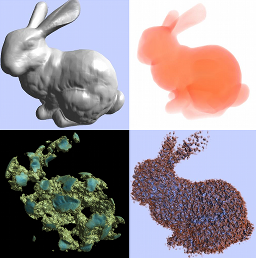
Requirements
You can use GigaVoxel s renderer in GLSL but full GigaVoxels - especially the dynamics allocation, production and loading - is based on the Nvidia CUDA library. You will need a Nvidia graphics cards : at least a Fermi with a compute capability 2.0 and Cuda >= 7. GigaVoxels/GigaSpace is available on Windows (W7 or more) and Linux (Ubuntu 14 or more).Downloads
- Registration form.Windows and Linux packages and archives:
- Go to download directory.Via INRIA-forge and svn:
How to start
Once you installed the data, either :NB: defaults values or side effects in GvViewer can be missleading.
And some tutos differ by the programming approach more than by what you see.
So, do have a look on the manual !
License
GigaVoxels/Gigaspace distributed under the BSD 3 free software license, for non-commercial as well as commercial use.
This program is distributed in the hope that it will be useful, but WITHOUT ANY WARRANTY; without even the implied warranty of MERCHANTABILITY or FITNESS FOR A PARTICULAR PURPOSE. See the BSD3 License for more details.
As a research center INRIA cannot ensure long term software maintenance, but a community out of INRIA might help you on, and INRIA might be able to answer or redirect concerning special needs (e.g. development, formation). For both, see contact.
Funding
GigaVoxels has been developped during the PhD thesis of Cyril Crassin (granted by the French Research Ministry via Grenoble University), under the advising of Fabrice Neyret (CNRS).GigaVoxels was supported and funded by ANR via the "veRTIGE" project (Real-Time Interactive & Galaxy for Edutainment) of reference ANR-10-CORD-0006
Many other partial fundings and human participants have help or experimented directly or indirectly. Engineers (Morgan Armand, Pascal Guehl, Jeremy Sinoir, Paul Gannay), practice students, co-authors of the various papers, collegues in labs of companies with precious advices, and peoples from various INRIA support services... Thanks to all of them !